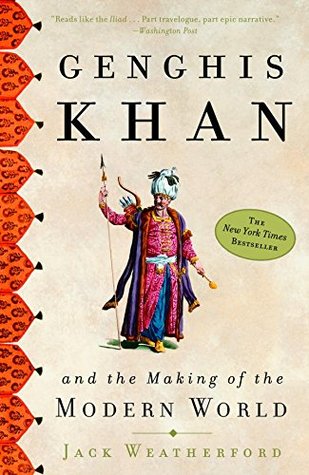Genghis Khan and the Making of the Modern World - Review by Abhishek Desikan
When we hear ‘Genghis Khan,’ it brings different images to one’s mind, with most depictions portraying him as a fierce warrior and ruthless tyrant from Mongolia who, at one point in time, ruled the world. We think of the thousands of people he butchered, the vast swathes of territories he conquered, and the influence he has on the planet to this day, with 1 in 200 people alive today still considered his direct descendants. But history, as we all know, is never black or white and is ridden with plots and sub-plots and inexplicable nuances which alter its course. And nowhere is this more self-evident than when we read about Temujin Khan (who later became Genghis Khan) and the Mongols and who they really were in this fascinating commentary by Jack Weatherford.
To begin with, what the Mongols achieved as a military civilization is most likely unsurpassed by any other empire/kingdom. In 25 years, the Mongol army subjugated more lands and people than the Romans had conquered in four hundred years. As a measure of the total area occupied, number of people defeated or countries annexed, Genghis Khan conquered more than twice any other man in history. And he achieved all this with a tribe of under a million people and warriors just numbering a hundred thousand.
Khan’s military tactics were unique and impressive, and they relied heavily on their fleet of horses during execution. They could easily ride and fight even on frozen rivers and lakes. They also split into two camps, first drawing the enemy and spreading them thinly before launching a swift and brutal attack to subjugate them.
More importantly, they used propaganda very effectively. The terror in people’s minds and hearts when they heard the word “Mongols” did more damage to their morale than anything else. They inflated the number of people killed in battle and the gruesome way they did it, weakening the enemy even before lifting their swords.
Genghis Khan and his descendants ruled from Europe to Korea, Siberia to India, Vietnam to Hungary, and China to Persia. The scale and scope of his achievements escape any logic or reason.
But there is so much more about the Mongols and Genghis Khan, buried in the sands of time. And it is this journey of the great Khan and his descendants that the author narrates. From his birth to his rise as a tribal leader and, ultimately, a warrior who fiercely fought for his people’s safety. His children and grandchildren continued to expand his territories on the firm foundation he established while possibly establishing the first global order based on free trade, single international law, and a universal alphabet to write in all languages.
Khan was fierce and challenged the notions and conventions of his tribe. He smashed the privileges-by-birth system and built one based on merit and loyalty. He also lowered taxes for the public and abolished them for doctors, priests, and educational institutions. He established a census and created the international postal system. And he was not an emperor who conquered for wealth, and all the goods and gold he got from wars were evenly distributed among his folk. The Mongols and Khan were animists and believed in the ultimate supreme law of the Eternal Blue Sky and his spirit banner, which applied to all people. They were egalitarian and secular in their outlook toward all religions. He also abolished torture, refused to hold hostages, and instead instituted the practice of diplomatic immunity for ambassadors end envoys. Those who attacked Mongol ambassadors, though, were brutally eviscerated.
Mongols gave a lot of importance to artists, scientists, astronomers, and men of wisdom in all places they conquered. They realized their value and had a practical outlook toward the conquered territories and their subjects. As the Mongol empire grew over centuries, this exchange of ideas, information, trade, culture, and practices across civilizations and religions gave birth to many innovations in finance, medicine, science, literature, industry, and so on.
The downfall of the Mongols was triggered not by a conquering enemy but rather by a virus - the Black Plague. The plague wreaked havoc across the length and breadth of the Mongol empire, killing millions in the process, diminishing their military strength, and reducing them to trading kingdoms. Eventually, other claimants, like Timur, usurped the Mongol territories while vehemently claiming their descent from the Great Khan to showcase their legitimacy and strength to the public. The Mughals who invaded and ruled India also were descendants of the Mongols.
The Mongols significantly influenced every aspect of Eastern and European life, including technology, warfare, clothing, etc. But, the rise of Europe as a superpower post the 18th century was a blow to the legacy of the Mongols as they were systematically removed from collective memory, with their glowing achievements laying forgotten and their alleged crimes and brutality greatly magnified. This was mainly the result of 19th-century scientists who wanted to show the inferiority of Asian and Eastern populations, even classifying them as Mongoloid. Ultimately, Mongols came to represent failure, barbarity, and uncouthness, becoming a scapegoat for individual and nationalistic shortcomings.
Later in the 20th century, the revisionist history of the Mongols began. It had unlikely champions like Nehru, for example. The author and like-minded folks were part of this revival and went through rigorous and physical hardships to recover the most crucial document telling the story of the Mongols from their own perspective. Known as “The Secret History of the Mongols,” it is what forms the foundation of this book.
One cannot narrate the history of humans and civilizations without prominently featuring Genghis Khan and the Mongols. They’ve withstood the test of time through all their triumphs and failures.

Also published here.